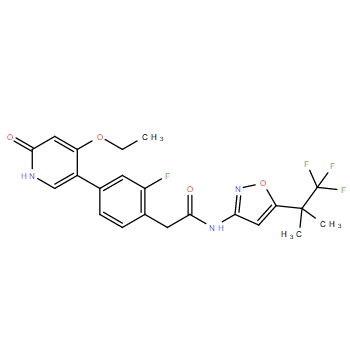| Description: |
GSK3179106 is a RET kinase inhibitor extracted from patent WO2014141187A1, compound example 27, has an IC50 of < 100 nM. |
| Target: |
IC50: < 100 nM (RET kinase)[1] |
| In Vitro: |
The patent WO2016038519A1 describes a series of compounds which are indicated as inhibitors of the Rearranged during Transfection (RET) kinase, and which are indicated as being useful in the treatment of RET-mediated disorders. Specifically disclosed in that application is the compound RET Kinase inhibitor 1 (Compound A)[2]. |
| Kinase Assay: |
Human RET kinase cytoplasmic domain is expressed as an N-terminal GST-fusion protein using a baculovirus expression system. GST-RET is purified using glutathione sepharose chromatography. The RET kinase enzymatic assay is performed in a total volume of 10 uL with increasing concentrations of RET kinase inhibitor as a singlet in a 384 well format as follows: RET inhibitor compound plates are prepared by adding 100 nL of RET inhibitor at different concentrations to a 384-well plate. 5 μE/well of a 2X enzyme mix (50 mM HEPES; 1 mM CHAPS; 0.1 mg/mL BSA; 1 mM DTT; 0.2 nM RET kinase) is added to the 384-well plate and incubated for 30 minutes at 23°C. 5 μE/well of a 2X substrate mix (50 mM HEPES; 1 mM CHAPS; 0.1 mg/mL BSA; 20 μM adenosine triphosphate; 20 mM MgCl2 and 1 μM biotinylated peptide substrate) is added and incubated for 1 hour at 23°C. 10 μE/well of 2X stop/detection mix (50 mM HEPES; 0.1 % BSA; 800 mM Potassium Fluoride; 50 mM EDTA; 200 X dilution of Europium Cryptate labeled anti- phosphotyrosine antibody; 62.5 nM Streptavidin-XL665) incubated for 1 hour at 23°C and read on a Homogenous Time-Resolved Fluorescence reader. IC50s are fitted using GraphPad Prism to a sigmoidal dose response[1]. |
| Cell Assay: |
Human RET kinase cytoplasmic domain is expressed as an N-terminal GST-fusion protein using a baculovirus expression system. GST-RET is purified using glutathione sepharose chromatography. The RET kinase enzymatic assay is performed in a total volume of 10 uL with increasing concentrations of RET kinase inhibitor as a singlet in a 384 well format as follows: RET inhibitor compound plates are prepared by adding 100 nL of RET inhibitor at different concentrations to a 384-well plate. 5 μE/well of a 2X enzyme mix (50 mM HEPES; 1 mM CHAPS; 0.1 mg/mL BSA; 1 mM DTT; 0.2 nM RET kinase) is added to the 384-well plate and incubated for 30 minutes at 23°C. 5 μE/well of a 2X substrate mix (50 mM HEPES; 1 mM CHAPS; 0.1 mg/mL BSA; 20 μM adenosine triphosphate; 20 mM MgCl2 and 1 μM biotinylated peptide substrate) is added and incubated for 1 hour at 23°C. 10 μE/well of 2X stop/detection mix (50 mM HEPES; 0.1 % BSA; 800 mM Potassium Fluoride; 50 mM EDTA; 200 X dilution of Europium Cryptate labeled anti- phosphotyrosine antibody; 62.5 nM Streptavidin-XL665) incubated for 1 hour at 23°C and read on a Homogenous Time-Resolved Fluorescence reader. IC50s are fitted using GraphPad Prism to a sigmoidal dose response[1]. |
| References: |
Human RET kinase cytoplasmic domain is expressed as an N-terminal GST-fusion protein using a baculovirus expression system. GST-RET is purified using glutathione sepharose chromatography. The RET kinase enzymatic assay is performed in a total volume of 10 uL with increasing concentrations of RET kinase inhibitor as a singlet in a 384 well format as follows: RET inhibitor compound plates are prepared by adding 100 nL of RET inhibitor at different concentrations to a 384-well plate. 5 μE/well of a 2X enzyme mix (50 mM HEPES; 1 mM CHAPS; 0.1 mg/mL BSA; 1 mM DTT; 0.2 nM RET kinase) is added to the 384-well plate and incubated for 30 minutes at 23°C. 5 μE/well of a 2X substrate mix (50 mM HEPES; 1 mM CHAPS; 0.1 mg/mL BSA; 20 μM adenosine triphosphate; 20 mM MgCl2 and 1 μM biotinylated peptide substrate) is added and incubated for 1 hour at 23°C. 10 μE/well of 2X stop/detection mix (50 mM HEPES; 0.1 % BSA; 800 mM Potassium Fluoride; 50 mM EDTA; 200 X dilution of Europium Cryptate labeled anti- phosphotyrosine antibody; 62.5 nM Streptavidin-XL665) incubated for 1 hour at 23°C and read on a Homogenous Time-Resolved Fluorescence reader. IC50s are fitted using GraphPad Prism to a sigmoidal dose response[1]. |






















